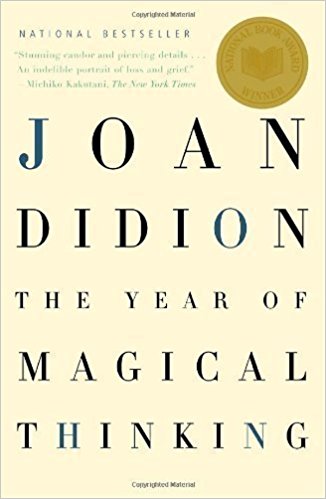Summary | Excerpt | Reading Guide | Reviews | Beyond the Book | Read-Alikes | Genres & Themes | Author Bio

Critics' Opinion:
Readers' Opinion:
First Published:
Oct 2005, 240 pages
Paperback:
Feb 2007, 214 pages
Please be aware that this discussion guide will contain spoilers!
The questions and discussion topics that follow are designed to enhance your group’s discussion of Joan Didion’s powerful, National Book Award–winning memoir, The Year of Magical Thinking. A spare, lucid, and remarkably moving examination of the year following her husband’s sudden death just before their fortieth anniversary, it is the story of Didion’s search for answers, for relief, and above all for the chance to change the course of events. Filled with often surprising insights and more than a dash of humor, it is one of the most critically acclaimed books of the decade.
A selected bibliography, The Year of Magical Thinking:
The Hour of Our Death and
Western Attitudes Towards Death: From the
Middle Ages to the Present, Philippe Ari's; “Mourning and Melancholia,”
Sigmund Freud; “Mourning and Its Relation to Manic-Depressive States,” Melanie
Klein; A Grief Observed, C. S. Lewis; The Magic Mountain, Thomas
Mann; “The Forsaken Merman,” Matthew Arnold; The Ascent of F6, W. H.
Auden and Christopher Isherwood; Bereavement: Reactions, Consequences, and
Care, compiled by the National Academy of Sciences’ Institute of Medicine;
Dutch Shea, Jr., Harp, and True Confessions, John Gregory
Dunne; Emily Post's Etiquette; Death, Grief, and Mourning, Geoffrey Gorer;
How We Die, Sherwin B. Nuland; Intensive Care: A Doctor’s Journal,
John F. Murray, M. D.; Clinical Neuroanatomy, Stephen G. Waxman, M.D.; A Book of Common Prayer,
Democracy, The Last Thing He Wanted,
and Play It As It Lays, Joan Didion; Alcestis, Euripides; Leftover Life to Kill, Caitlin Thomas
For further reading:
Darkness Visible: A Memoir of Madness,
William Styron; A Slender Thread, Diane Ackerman; Night Falls Fast, Kay Redfield
Jamison; The Burn Journals, Brent Runyon
Unless otherwise stated, this discussion guide is reprinted with the permission of Vintage. Any page references refer to a USA edition of the book, usually the trade paperback version, and may vary in other editions.





The Funeral Cryer by Wenyan Lu
Debut novelist Wenyan Lu brings us this witty yet profound story about one woman's midlife reawakening in contemporary rural China.
Your guide toexceptional books
BookBrowse seeks out and recommends the best in contemporary fiction and nonfiction—books that not only engage and entertain but also deepen our understanding of ourselves and the world around us.